

Check Mushrooms. Special 4 Mushroom-Hunters. Poisonous Plants. Baneberry. Poison Ivy. Moonseed. Poison Sumac. Note on Eating Alder Catkins. Wild plants as survival food. Wild edible plants, fruits, berries and nuts are one of the survivor's most important foods.

When planning your wilderness trip make sure you learn the plant life of the region you are going to visit. As already said, knowledge of only one or two edible plants can be of great help in your search for survival food. Poisonous plants Nature has a lot of edible plants to offer, but it also has a lot of poisonous plants. There are many good rules on plants to avoid, for instance, any plant that has a milky sap or white berries. Edibility test You can find descriptions of plant edibility tests in wilderness survival literature. If you are unlucky and pick the wrong plant, you will have some serious problems. 19 wild plants. Wild Garlic. Jerusalem Artichoke.
Wild Leeks. Garlic Mustard. Broadleaf Plantain (Plantago major) Indian Cucumber Root. Agave Root. Wild Carrot. Fiddleheads. Trout Lily. Mayapple. Nettles. There are several species of nettles.
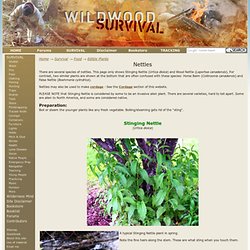
This page only shows Stinging Nettle (Urtica dioica) and Wood Nettle (Laportea canadensis). For contrast, two similar plants are shown at the bottom that are often confused with these species: Horse Balm (Collinsonia canadensis) and False Nettle (Boehmeria cylindrica). Nettles may also be used to make cordage - See the Cordage section of this website. PLEASE NOTE that Stinging Nettle is considered by some to be an invasive alien plant. There are several varieties, hard to tell apart. Preparation: Boil or steam the younger plants like any fresh vegetable. Blueberry. Gooseberries. Temperate North America and the UK. Now FREE!!
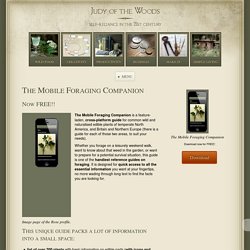
Image page of the Rose profile. The Mobile Foraging Companion is a feature-laden, cross-platform guide for common wild and naturalised edible plants of temperate North America, and Britain and Northern Europe (there is a guide for each of those two areas, to suit your needs). Whether you forage on a leisurely weekend walk, want to know about that weed in the garden, or want to prepare for a potential survival situation, this guide is one of the handiest reference guides on foraging. It is designed for quick access to all the essential information you want at your fingertips, no more wading through long text to find the facts you are looking for. This unique guide packs a lot of information into a small space: What is the difference between the N.
There isn't a lot of difference, as most of the plants included grow throughout most of the temperate northern hemisphere. Common names of plants vary, so each guide is written with the appropriate names for those countries. Advertising. Edible Plants. Tom Brown, Jr.It's very difficult to write a survival article on wild foods that will be relevant to readers in a broad range of areas and terrains.
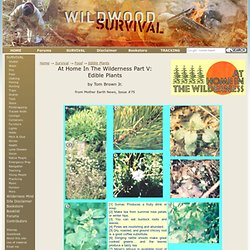
Therefore, I've tried to include a variety of widely distributed plants that can be easily identified and are—for the most part—to be found throughout the year. Remember, though, that when a person sets out to gather wild edibles, he or she must do so with a great deal of caution. Edible Wild Plants. Photo by Filip Tkaczyk How Do I Know What Plants Are Safe to Eat?
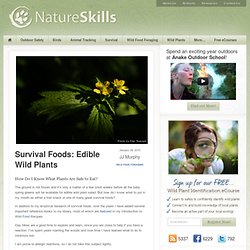
The ground is not frozen and it’s only a matter of a few short weeks before all the baby spring greens will be available for edible wild plant salad. But how do I know what to put in my mouth as either a trail snack or one of many great survival foods? In addition to my empirical research of survival foods, over the years I have added several important reference books to my library, most of which are featured in my Introduction to Wild Food Recipes. Day hikes are a good time to explore and learn, since you are close to help if you have a reaction.
I am prone to allergic reactions, so I do not take this subject lightly. There are a few steps you can take when exploring the plant world for survival foods that will guide you in this discovery process. Understand the basic parts of an edible wild plant – root, stem, leaves, buds, flowers, fruit and seed. Study the plant. Edibility of Plants. The information on this page is presented in an older format.
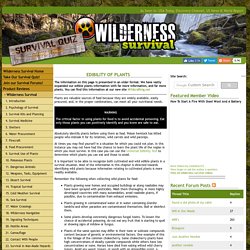
We have vastly expanded our edible plants information with far more information, and far more plants. You can find this information at our new site Wildcrafting.net Plants are valuable sources of food because they are widely available, easily procured, and, in the proper combinations, can meet all your nutritional needs. Eat Weeds. Edible Landscaping. How To Prepare Survival Food;The Survival Bible.